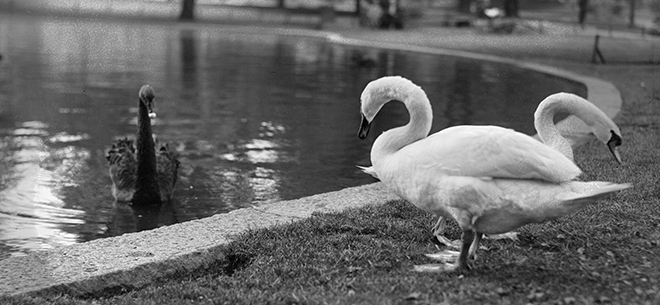
The Swan Boats at the Boston Public Garden have been a famed seasonal fixture at the country’s oldest public botanical garden since 1877. The barges’ flesh-and-feather counterparts, however, have been treading the park’s waters for even longer, and may have even provided the inspiration for the pedal-powered vessels.
Transferred annually to much fanfare from their winter abode at the Franklin Park Zoo in a 31-year-old ceremony dubbed the Return of the Swans, a mute swan couple are May through October residents on the Public Garden Lagoon. Live swans gliding about on this tranquil body of water goes back much farther than this relatively new tradition, however. According to literature provided by the Friends of the Public Garden—a non-profit dedicated to helping preserve and maintain the Public Garden, Boston Common and Commonwealth Avenue Mall—$4,200 was allocated in 1868, nine years before the debut of the Swan Boats, for a swan house at the park. Those crafts were modelled after a scene in German composer Richard Wagner’s 1850 opera Lohengrin, yet there seems to have been a living example already extant on the pond. The practice of having several semi-domesticated swans in this location for the warmer months persisted until the 1960s before being revived in the aforementioned rite of spring in 1991.
The Public Garden swans have mainly been mute swans, a species native to Europe and Asia that has long been popular here for its elegant, decorative quality. There does appear to have been a black swan, reportedly nicknamed Sam, during the 1920s and ’30s, as evidenced by the above photo. One widely publicized story about the contemporary, mated-for-life mute swans, Romeo and Juliet, broke in 2005 when tests revealed that both birds were actually female. Many found an ironic symmetry in this discovery, as Massachusetts had just legalized marriage equality. The waterfowl, named for a longtime male/female duo that preceded them, have nevertheless been laying eggs annually. Although not a tragedy of Shakespearean proportions, the unfertilized eggs never hatch and are eventually removed from their nest.


